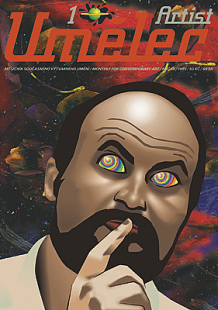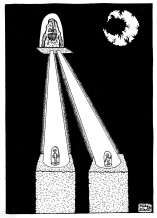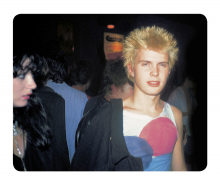| Umělec magazine 2009/1 >> The World Engulfed by Technology: A Critique of New Media | List of all editions. | ||||||||||||
|
|||||||||||||
The World Engulfed by Technology: A Critique of New MediaUmělec magazine 2009/101.01.2009 Palo Fabuš | essay | en cs de es |
|||||||||||||
|
There is perhaps no term more problematic than newness. Despite its ambiguity, this word is surrounded by other generally unexpressed words. First and foremost, “new” always implies the possibility of change. It brings with it hope, and the suggestion of something different, something previously unknown and potentially better than what has existed before.
New also means unexplored, uncertain, unproven. It draws its content from its own context and is always-already engaged in maturation or self-examination. Because this path away from newness leads through a field of possibilities, the shape of the new is constantly—if not dramatically—changing, and its resemblance to its original form gradually disappears, while new, unexpected features appear. The non-new lies at the end of this path, with a relatively fixed form for the first time. The initially dominant possibilities have “stiffened” to requisites and are merely a thin layer on the surface. It has already been possible to assert for some time now that the field of culture, whose agenda flew the flag of “the new,” has entered a non-new state. New media is no longer new, and whether we understand it as a part of culture, a set of technologies, a field of studies, or a specific discourse or art form, its basis and catalyst was an ideology—an ideology whose promising potential has already largely burned out. This may be most true for the field of the so-called “new media arts,”1 so we will look at what this ideology consisted of, from whence it drew its motivation, and most importantly, why it fell quiet after such an intense initial wave of enthusiasm. It is not surprising that the question of the demise of new media is not asked often or out loud. The enthusiasm, that once surrounded new media, has faded away rather than burned out, which is common with trends and questions of fashion. But new media had always set goals for itself beyond common, superficial tendencies. According to its own ideas, it was meant to herald a new artistic (and eventually cultural) paradigm. So why didn’t it lead anywhere? According to Geert Lovink, the problem is that new media never extended beyond its own frame of reference—it remained a closed and self-referential field.2 It is not surprising that the disinterest of mainstream cultural institutions became a topic of “ever-present sentiment” in the field of new media.3 This alleged obliviousness was justified with institutional explanations,4 historical comparisons to how long it took for people to accept photography and video art as part of mainstream art,5 and claims th at it was the result of an ambivalence toward the term “new media” itself.6 No one looked for a problem within new media itself, however. As we will see, claims about the mainstream ignoring the new media are only partially true. However, the position and meaning of new media, which had proclaimed its future importance, cannot be understood without looking into the spirit of the period from which they came. Sociologists and historians speak of a culmination of historical processes whose characteristics merge into our daily lives. As a result, we have a tendency to overlook these processes and the important constituent elements of today’s situation, in which the art of new media is a significant expression of the spirit of the day. Therefore, examination of the position and significance of new media is, first and foremost, a historical inquiry. New Media under the Microscope of History New media was connected in its beginnings—at a time of rapid democratization in the realm of information technology—with an important historical breakthrough, a cultural revolution, a promise of something better. The ideology that developed around new media was built on shaky foundations; new media shut itself off from the influence of socio-cultural history, and—to paraphrase Marshall McLuhan—drew on its background like a child painting on the casing of an atom bomb. Theories of contemporary society, sometimes labeled late modernity, look back at processes that began in the 17th and 18th centuries with a gradual refusal of the dogmas by newly-born natural sciences. These new stances, along with changes in the political climate and social institutions, accompanied capitalism’s emergence. British sociologist Anthony Giddens has identified three types of discontinuity in this shift from traditional to modern society: 1) a growth in rapid changes, 2) their global reach, and 3) the character of modern institutions (new social formations like the nation-state, for example).7 Along with questions on the meaning of history, the idea of progress as part of the work of man comes to the foreground.8 Distinctly assisted by the protestant ethic, a new ethos appears, characterized by “a turn to the world”—its basic attitude towards the world becomes “its domination.”9 This leads to an internalization of personality and a systematization of life. Emphasis is placed on self-discipline, enduring work and rational interactions.10 Until then, an orientation to the past was based on re-interpreting its traditions. This quickly makes way for a focus on the future.11 Through the processing of time by mechanical watches and money as “frozen work,” time-spatial relations have been separated, and social systems organized as such have escaped their original contexts—this so that they would reconfigure themselves in the new set up.12 Communication and relationship maintenance need no longer take place face-to-face—space becomes increasingly “phantasmagoric.”13 This requires members of society to place more trust in institutions and systems with which they do not have immediate interaction. An increasingly intense polarization of trust and risk, threat and opportunity, local and global pervades all aspects of everyday life14 and increases the demand for reflection. This means that social practice is constantly reviewed and adjusted based on observations of this practice. Today we are already experiencing a radicalized form of these processes. Rationalization in the form of modern sciences, technologies and reflexivity affects all of society’s—as well as the individual’s—everyday life; it represents important constituents of today’s society and leads to the development of further characteristics. After the Second World War, sudden economic development and gradual decreases in the number of working hours led to the “discovery” of free time. This created favorable conditions for the introduction of television as a new medium, as well as an increased attentiveness to the quality of one’s own life in the form of therapeutic sensitivity during the 1960s. People began to speak and dress in public as if they were at home. They had increasingly large amounts of time for the consumption of mass culture and for personal introspection. “Out of Post-modernism came an era of liberation.”15 Internal life was rationalized by constructing false dreams and escaping from reality, and this was done to an extent only possible within mass culture, which reinforces the hunger for it. The commodification of a visual culture that reciprocally strengthens itself with the aestheticization of everyday life leads to a “society of spectacle,” and this reflexivity culminates in the phenomenon that Christoph Lasch labels “narcissism.” Lasch observes that while in the 18th and 19th centuries portraits served as an indicator of social status and the documentation of individual existence, the easily-accessible photographic (and later video) technologies offer a medium for permanent self-contemplation. They create a narcissistic dependence on the consumption of images of oneself and re-assessment of the external world’s reality.16 A performing personality is a typical by-product of narcissism. Modern society views the Self as a performer, constantly being watched by friends and strangers.17 The social trend of accentuating style according to aesthetic pressure is pervasive. The shift from the manufacture of goods to the manufacture of images has made art mundane. Increasingly, this blurs the boundaries between high and low art and between the performer and his or her audience. “The diffused audience,” —the audience, of which we are all members all the time—makes everyday life an unceasing, constant performance. Then, digital technologies entered the picture. They have been viewed as a beneficent power from the beginning. The enormous expansion of personal computer technologies during the 1980s, later rubber-stamped by the birth of the World Wide Web in the early 1990s, illustrates a dual impulse for ideology to thrive in the fields of culture as well as in economics and politics. This leads to a new call for unrestricted ideas on decentralization and sudden democratic development, as well as a resuscitation of the ideas of Marshall McLuhan on “the global village” dating from the 1960s. There is a significant abundance of terms such as “revolution,” “new society” and “new culture.”18 The unintended consequences of this ideology, described as “communicational” by Jaromír Volek, soon became apparent. The long-term tension typical of modernity showed itself here as a clash between portended social integration, cultural assimilation and traditional community norms on one hand, and a tendency toward social differentiation and cultural diversity on the other.19 Volek found this to be a fundamental feature of communication, which “in itself became a social grace.”20 The initial enthusiasm partially subsided in the new millennium with the bursting of the dot-com bubble in 2000, the collapse of the myth of a “borderless” internet, the censorship of web-site content in non-democratic countries and the increasing number of cases of such abuses of information technology. Last but not least, since the beginning of the 1990s, new global problems, such as terrorism and global warming, have come to the fore. Grand ideologies are a thing of the past and each new imperative and authority is only another potential subject for impugnation. Personal freedom and self-realization become the top priority. Modern man thus finds himself in a world steeped in possibilities. The magic of novelty, this vehicle for possibility, is thus once again reborn in the spirit of technology. Technological Attraction Even though she [Agnes] was a cybernetics expert, she didn’t have any idea what was gong on in the head of that machine which was as strange and impenetrable to her as the mechanism of the various objects with which she daily came into contact, from the small computer next to her phone to the dishwasher. In contrast, Goethe lived during that brief span of history when the level of technology already gave life a certain measure of comfort but when an educated person could still understand all the devices he used Goethe knew how and with what materials his house had been constructed, he knew why his oil lamp gave off light, he knew the principle of the telescope ...and the world of technical object was understandable and fully exposed by his sign. Milan Kundera, Immortality The opaqueness and attractiveness of advanced technologies cause them to be compared to magic in both fiction and scholarly literature. Let’s recall just one of the well-known “laws” of author Arthur C. Clarke. According to Clarke, each sufficiently advanced technology is indistinguishable from magic. Arnold Gehlen sees here an anthropological fundamental that is responsible for this, an automation inherently present in nature, or phenomenologically perceived in the world as a self-propelled circuit.21 No wonder, that one of the most sought after holy grails in technology, up until the discovery of thermodynamic laws, had been perpetuum mobile. The enchantment of technology, as the embodiment of the endeavour for technical understanding, does not fundamentally differ from the wonder of evolution as nature’s accomplishment—something we gladly forget in the techno-scientific world. Technology’s ambiguity did not show up in history all by itself. As has already been said, a far-reaching rationalization led not only to the development of new technologies, but also to intellectualization in the purely spiritual realms of the arts and sciences. A bankruptcy of clarity, immediacy and easy access occurred not only because of resulting technologies acting as artifacts and processes, but also because of their creation. As early as the 19th century, the role of the inventor as a creative individual was banished to the outer limits of this period of fast-paced progress or to literary and film reserves, where they take on the form of mad scientists or absent-minded old people. Technological development has long been an issue explored by large research teams with the tasks divided amongst themselves, and as such their results are pieced together by an anonymous mob of easily interchangeable and confused people from institutions with vested interests. Their objectified nature then makes developing technology into one of “discovery,” “emergence” or literally “falling from the heavens.”22 As we will show later, technology draws more attention than it truly deserves. This feature played and continues to play the role of a loud melody in the cacophony of an increasingly complicated world that lacks a conductor. This comparison to music is not without purpose. We even have a tendency to perceive technologies in time, i.e. as placed within a time continuum. Technological development represents a replacement model for advances in civilization, on which, in this case, the direction has been marked—forward. When we ask about progress, technology overshadows changes in the political environment, morals, art and even general cultural values. It is therefore understandable that not even history could resist this temptation and marked the dates of invention as important technological conquests. It shows them as replacement milestones for civilization’s advances. The Steam Age, the Atomic Age, the Age of Computers. Technology was responsible for changes in perception (Marshall McLuhan) and even the character of empires (Harold Innis). Innis and McLuhan, both representatives of the so-called Toronto School, are of course not the only ones who emphasised technologies’ guiding role in their search for the causes of social change. In academic circles, this theoretical tendency labeled “technological determinism” was in its prime mainly between the 1950s and 1980s. For the most part it is already passé, but it has held on fairly consistently from the 19th century through today as part of lay contemplation.23 Evidence of this exists in the revival of Marshal McLuhan’s thoughts in the 1990s—specifically in the area of new media, which adopted him as a patron, rashly supposing itself to have fulfilled his prophecy. Today we know that historical processes and changes in living conditions cannot be explained by just one factor. Technologies are always-already part of a culture and are neither a cause nor a consequence thereof.24 Simply put, we shape technology and technology shapes us. Technology is not a drop of ink that, when dropped into a glass of water, colors the whole content.25 Even digital technology seemingly came to the foreground later than was theoretically possible, taking the form of personal computers in the period up to the mid-1970s—at a time when technologies were associated with loathed capitalism and the Vietnam War.26 Incidentally, the whole field of new media proved to be strongly inclined to an artificial separation of technology from culture and society.27 Novelty and a World of Possibilities As mentioned at the start of this article, technologies have two moments. These are novelty and the possibilities which arise from it. In his analysis of the relations between technology and global history in the 20th century, David Edgerton comes up with an interesting observation: Too often, we understand the term technology to mean new technology.28 As a result, we do not take into consideration the fact that we are surrounded primarily by old technologies, whose roles in our everyday lives are fundamental. This type of selective blindness—amplified by media—explains why in the 1950s one spoke of the Atomic Age, or why the interest in rockets at the time fuelled visions of space travel. The One Laptop Per Child project is a contemporary example.29 One might take exception with this claim by pointing out that people still pay attention to old technologies from the 19th and 20th centuries. But doesn’t this stem from the fact that once upon a time they represented the future?30 When we consider this picture from an historical point of view, we notice that the written history of technology is misleading. This is because instead of focusing on which technologies were actually used during which time periods, we tend to focus on new discoveries.31 The “history of discoveries” overshadows the “history of uses” and completely ignores the fact that used technologies have more testimonial value than discovered technologies because a relatively large amount of time passes before new technologies are used in practice. As has been said, the novelty around us expands the field of possibilities. Discovery—new technology—represents this field of possibilities (uses), whereas actively used or successful technologies create the field of necessity.32 Possibility is too often confused with necessity. We somehow automatically expect that each and every new technology is bound to be successful. Fiction too often replaces reality. In 1944, George Orwell complained about the historical repetition of the concepts of “erasing distance” and the “disappearance of borders”—the same concepts new media was also supposed to use as mottos33 The question remains, why? The essential feature of possibility is that it aims to the future. In a society whose rhetoric is focused on the future, possibilities become resounding arguments.34 Notice how the discourse of new media is oriented toward questions related to what all this new media enables. The question of how new media is actually used is always pushed to the periphery. For example, the possibility of communicating instantaneously with anyone on the planet—for how many of us is the use of this possibility a common practice? We live in communities, both local and interest-based, and new media strengthen them. The idea of the global village ignores the fact that we live in a physical space and tend to remain therein. If the fear of escape into a fictitious world was ever considered justified, the culprit was not new media or a computer-generated, artificial world, but rather the vision of a world made up of mere possibilities. Isn’t this world and the “information society” in which we supposedly live the one and the same thing? If we dissect this label, which is partially accepted and partially criticized for its ideological basis, an in-depth analysis shows it to be minimally problematic. Frank Webster, who researched the main arguments for its use,35 came to the conclusion that most of the arguments are based on tautology and indiscriminate usage of the term “information.” He points out that it is often forgotten that the value of theoretical discourse is increased. It cannot be ignored that this circumstance influenced the field of new media. The frequently criticized fetishistic implications only negligibly impacted ideology, which is mainly the product of new media theory and in no way falls short of what is happening in practice. A truly sincere effort to understand the world that new media has helped to create has collided with the factors described above. Overestimating the role of technology in socio-cultural changes and ignoring technological critiques has created an extremely distorted image of reality. Faith in technology and the possibilities it offers took on the unique appearance of “objective reality.” This phenomenon allowed itself to get swallowed up by its own interpretation,36 which created false expectations and baseless motivation. Technology as a stance “At worst we are at the mercy of technology, when we consider it to be neutral. This makes us blind towards it.” Martin Heidegger, The Question Concerning Technology. So what then is the position of new media? Geert Lovink, who has asked the same question, arrived at the conclusion that new media will never be accepted by mainstream cultural institutions and art collectors.37 Such a claim is problematic from the outset in that it does not distinguish between two important approaches in art working with new media. In the first approach, the new media serve either as a mere means to an end and/or as a reflected topic or subject. This approach clearly did not have any problem in permeating the aforementioned artistic circles. Both galleries and collectors gradually accepted artists working with new media. Today their works are part of important collections and are shown regularly. This includes internet art as well, which is supposedly less acceptable.38 What is characteristic of these artists is that they do not push these (new) media to the forefront. Often they are only one of many media with which an artist works. Stated another way, artists do not understand new media to be a stance. This is, however, typical for the other approach to new media, i.e. with art, which mainly labels itself with the tag “new media art.”39 The objection that works of art using new media on a purely instrumental level are underrepresented in galleries lacks substantiation. One can read between the lines that this comes from the second approach, which pushes the medium to the fore. It is as if the quality of such art (or perhaps the fulfilling of gallery quotas?) should automatically stem from the non-critical acceptance of the media. Can technology function at all as an artistic stance? We have already discussed what it is about new media that makes the technologies themselves attractive and how they distort the image of reality. The nature of this stance still remains hidden to us. According to Martin Heidegger, this is because the essence of technology is not technical.40 An all-encompassing relationship to the things around us is hidden behind today’s technology. Our approach to today’s world has not always been the same. It changed subtly with the shift from manual to machine labour, and this is when our relationship with nature changed from one of dependency to one of subjugation. According to Heidegger, the most obvious difference between a windmill and a hydro-power plant is that we no longer build powerplants into the river’s flow, but rather the river’s flow is built into the powerplant. This state, which Heidegger calls Gestell and for which “challenging forth” (Herausfordern) are typical, causes the bankrupting of authenticity. Ivan Blecha summarizes the philosopher’s opinion well: “Technology observes the world in a narrow optic and in return produces products that in turn can only be created in this optic. This shuts us into a false world of demands, which (technology) itself has brought into the world, into the series of installments, in its own interests and by no means in the interest of reality.”41 Heidegger’s critique of Gestell in no way implies a rejection of technology as such. Indeed, this is not even possible. He calls rather for an acknowledgement of this state and a detailed critique thereof. At least two activities are capable of doing so; anxiety (“a leaning toward nothingness”) and art, which can manipulate things so that they are kept closest to their original existential care..42 But the art identified with Gestell becomes a self-contradiction. New media art has thus fallen into the trap of technologism, a trap that Nam June Paik had already warned us about when he emphasized the meaning of art for life with technologies. It only remains to state that with the onset of the new media before us, the variety of aesthetics is already, and definitively, opening wide. The mapping of this trend will only clarify its features with time, after we have seen what survives. Ultimately, we might even realize that we have tried to understand new media with old terms. 1. It is necessary to consider that the labelling of new media art never fully took hold and did not (bring about) any limitations. Here the features digital, interactive, electronic and technological are all interchanged. Last but not least, it concerned the pairing of the words “art” (or “culture”) and “technology”, or the mere emphasis on that which is media as being a priori new. The trend of extracting oneself from such designated positions, or even the silencing of protagonists of this approach, is hard to miss. For example, Armin Medosch notes in his article, “Good Bye Reality! How Media Art Died But Nobody Noticed” (2006) 2. Lovink, Geert: New Media, Art and Science: Explorations beyond the Official Discourse. In: Scott McQuire/Nikos Papastergiadis (ed.), Empires, Ruins + Networks, University of Melbourne Press, Melbourne, 2005. 3. Interview with Alessandro Ludovico, “Italian Hacktivism: Theory, Practice and History” (2008) 4. Interview with Andreas Broeckmann, “Contemporary New Media Art” (2007) < www.digicult.it/digimag/article.asp?id=823>; Kera, Denisa. 2006. “Od konspirace k emergenci: Umělecké vizualizace a estetika databází” (From Conspiracy to Emergency: Artistic Visualisation and the Aesthetic of Databases), pg. 36–39 In Flash Art (Czech & Slovak Edition) Vol. I, No.1. 5. See interview with Alessandro Ludovico. 6. Rišková, Mária. 2008. “Agónia a extáza umenia nových médií” (The Agony and the Ecstasy of New Media Art), In Flash Art (Czech & Slovak Edition) Vol. II, No. 9. 7. Giddens, Anthony. 1990. The Consequences of Modernity. Stanford: Stanford University Press. 8. Krasnodębski, Zdzisław. 2006. Zánik myšlenky pokroku. (The Disappearance of the Idea of Progress), Červený Kostelec: Pavel Mervart, pg. 23. 9. Ibid, pg. 108. 10. Ibid, pg. 110. 11. Giddens 1990, pgs. 37–38. 12. Ibid, pgs. 16–17. 13. Ibid, pgs. 18–19. 14. Ibid, pg. 148. 15. Prokop, Dieter. 2005. Boj o média. (The Fight for Media), Prague: Karolinum, pg. 317. 16. Lasch, Christopher. 1979. “The Narcissistic Personality of Our Time” Str. 31–51 In: The Culture of Narcissism. W.W. Norton. 17. Volek, Jaromír. 2002. “Nezamýšlené důsledky ‚komunikační ideologie‘ v kontextu informační společnosti” (The Unintended Consequences of „Communication Ideology“ in the Context of Information Society) In: Média a realita. (Media and Reality) Brno: Masaryk University in Brno, pg. 24. 18. In 1995 the publishing house, MIT Media Labu, published Nicholas Negroponte’s book, Being Digital, in which he labels bits as the new atoms. 19. Volek 2002, pg. 18. 20. Ibid, pg. 16. 21. Gehlen, Arnold. 1972. Duch ve světě techniky. (Spirit in the World of Technology), Prague: Svoboda, pg. 39. 22. Specifically in the field of internet, individuals – those who brought forth unique ideas that they successfully developed both commercially (Apple, Google, Napster) and non-commercially (Linux, torrent, wiki or the WWW itself) – are marginal albeit noticeable exceptions to these rules. These are, however, myth-creating exceptions, whose shelf-lives originate from our tendency to connect conquests of great importance with the stories of individuals. 23. Through this same gate we look not only at the past – how many visions of the future base themselves on significant scientific-technical discoveries? 24. Slack, Jennifer Daryl – Wise, J. Macgregor. 2002. “Cultural Studies and Technology” Pg. 485–501. In: The Handbook of New Media. Sage, pg. 487. 25. American media theoretician, Neil Postman, is the author of this techno-determinist comparison. 26. Tribe, Mark –Reena, Jana. 2006. New Media Art. Köln: Taschen. 27. Slack –Wise 2002, pg. 488. 28. Edgerton, David. 2006. The Shock of the Old. Technology and Global History Since 1900. London : Profile Books. 29. The aim of Nicholas Negroponte’s project is to provide schoolchildren in developing countries notebooks manufactured at very low cost. The naiveté of this project takes on very sharp contours when compared with the most important medical discoveries of the 20th century. One of these, according to Adam Hart-Davis, was the flushable toilet, which radically lowered child mortality and the danger of infectious diseases. However, the media is understandably much more interested in the notebook. 30. Edgerton 2006, pg. 38. 31. Ibid, pg. xii. 32. Necessary, that is, already-used technology is no longer understood to be new, and so it gets lost on the horizon of interest, as Edgerton pointed out. 33. As early as the 19th century railways were meant to pave the path to world peace and international understanding. Henry Ford generally attributed this potential to communications and transportation technologies. H.G. Wells believed on the other hand in aviation. 34. Henri Bergson says on his vision of the future: “The idea of a future filled with endless possibilities is more fertile than the future itself. Therefore one finds more beauty in hope than in property, in dreams than in reality.” He connects it with the feeling of joy, which “at its lowest level imitates the orientation of our spiritual states toward the future.” Bergson, Henri. 1994. Čas a svoboda. O bezprostředních datech vědomí. (Time and Freedom. On Immediate Dates of Cognition), Prague: Filosofia, pg. 17. 35. The arguments are based on changes in the social order, culture, economy, technological character and types of employment. Webster, Frank. 2002. “The Information Society Revisited” Pgs. 22–33 In: The Handbook of New Media. Sage. 36. Vopěnka, Petr. 1989. Rozpravy s geometrií. (Debates on Geometry) Prague: Panorama. 37. Lovink 2005. 38. The onset of art’s dematerialisation with the new media art is one of this discourse’s favourite myths. 39. Rišková 2008. 40. Heidegger, Martin. 2004. “Otázka techniky” (Technology Questions) pgs. 7–35 In: Věda, technika a zamyšlení. (Science, Technology and Contemplation) Prague: Oikoymenh. 41. Blecha, Ivan. 2007. Proměny fenomenologie. (Transformations in Phenomonology) Prague: Triton, pg. 231. 42. Ibid, pg. 233.
01.01.2009
Recommended articles
|
|||||||||||||
|
04.02.2020 10:17
Letošní 50. ročník Art Basel přilákal celkem 93 000 návštěvníků a sběratelů z 80 zemí světa. 290 prémiových galerií představilo umělecká díla od počátku 20. století až po současnost. Hlavní sektor přehlídky, tradičně v prvním patře výstavního prostoru, představil 232 předních galerií z celého světa nabízející umění nejvyšší kvality. Veletrh ukázal vzestupný trend prodeje prostřednictvím galerií jak soukromým sbírkám, tak i institucím. Kromě hlavního veletrhu stály za návštěvu i ty přidružené: Volta, Liste a Photo Basel, k tomu doprovodné programy a výstavy v místních institucích, které kvalitou daleko přesahují hranice města tj. Kunsthalle Basel, Kunstmuseum, Tinguely muzeum nebo Fondation Beyeler.
|






























 New book by I.M.Jirous in English at our online bookshop.
New book by I.M.Jirous in English at our online bookshop.
Comments
There are currently no comments.Add new comment